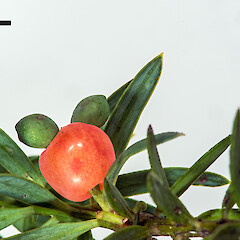Podocarpus totara var. totara
Common name
tōtara
Synonyms
Podocarpus totara G.Benn. ex D.Don
Family
Podocarpaceae
Flora category
Vascular – Native
Endemic taxon
Yes
Endemic genus
No
Endemic family
No
Structural class
Trees & Shrubs - Gymnosperms
NVS code
The National Vegetation Survey (NVS) Databank is a physical archive and electronic databank containing records of over 94,000 vegetation survey plots - including data from over 19,000 permanent plots. NVS maintains a standard set of species code abbreviations that correspond to standard scientific plant names from the Ngä Tipu o Aotearoa - New Zealand Plants database.
PODTOT
Chromosome number
2n = 34
Current conservation status
The conservation status of all known New Zealand vascular plant taxa at the rank of species and below were reassessed in 2017 using the New Zealand Threat Classification System (NZTCS) – more information about this can be found on the NZTCS website. This report includes a statistical summary and brief notes on changes since 2012 and replaces all previous NZTCS lists for vascular plants.
Please note, threat classifications are often suggested by authors when publications fall between NZTCS assessment periods – an interim threat classification status has not been assessed by the NZTCS panel.
- Conservation status of New Zealand indigenous vascular plants, 2017 . 2018. Peter J. de Lange, Jeremy R. Rolfe, John W. Barkla, Shannel P. Courtney, Paul D. Champion, Leon R. Perrie, Sarah M. Beadel, Kerry A. Ford, Ilse Breitwieser, Ines Schönberger, Rowan Hindmarsh-Walls, Peter B. Heenan and Kate Ladley. Department of Conservation. Source: NZTCS and licensed by DOC for reuse under the Creative Commons Attribution 4.0 International licence.
2017 | Not Threatened
Previous conservation statuses
2012 | Not Threatened
2009 | Not Threatened
2004 | Not Threatened
Distribution
Endemic. New Zealand: North Island, South Island and Stewart Island/Rakiura. Common throughout most of the North Island and South Island. Present but extremely scarce on Stewart Island/Rakiura (Freshwater River).
Habitat
Widespread and at times abundant tree of lowland, montane and lower subalpine forest. May also form a vegetation type in which it is the dominant species.
Wetland plant indicator status rating
Information derived from the revised national wetland plant list prepared to assist councils in delineating and monitoring wetlands (Clarkson et al., 2021 Manaaki Whenua – Landcare Research Contract Report LC3975 for Hawke’s Bay Regional Council). The national plant list categorises plants by the extent to which they are found in wetlands and not ‘drylands’. The indicator status ratings are OBL (obligate wetland), FACW (facultative wetland), FAC (facultative), FACU (facultative upland), and UPL (obligate upland). If you have suggestions for the Wetland Indicator Status Rating, please contact: [Enable JavaScript to view protected content]
FACU: Facultative Upland
Occasionally is a hydrophyte but usually occurs in uplands (non-wetlands).
Detailed description
Robust dioecious conifer up to 30 m tall. Trunk stout, 2–3 m diameter, clad in thick, corky, furrowed and somewhat stringy reddish-grey bark; without branches at base, branches stout, erect to spreading. Leaf bud narrower than or the same diameter as branchlet, surrounded by caducous, papery, narrowly lanceolate bracts. Leaves brownish-green, erect, leathery; juvenile 20 × 1–2 mm, adults 15–30 × 3–4 mm, linear-lanceolate, acute, apex pungent, mid-vein distinct to obscure. Male cones (strobili) axillary 10–15 mm, solitary or in 4s. Female branchlets axillary, ovules solitary or paired, receptacle of 2–4 scales, acute and free at tips, maturing as a red, swollen, succulent, sweet tasting “fruit” this surmounted by a 1–(2) broadly elliptic, ovoid-oblong 3–6 mm, semi-glossy, buff, grey nut brown, henna or dark brown (green to glaucous-green) when fresh, seed.
Similar taxa
Most frequently confused with Podocarpus laetus with which it may co-occur and with which it frequently hybridises. From that species P. totara var. totara can be distinguished by its thicker bark, less pungent leaf tips, and most readily by the leaf bud which is the same diameter as the branchlet, and by the narrower, lanceolate bracts surrounding the emergent leaves. See also Gardner (1990).
Flowering
(August)–October–(December)
Flower colours
No flowers
Fruiting
Fruits take a year or so to ripen, and may be found throughout the year, usually peaking at about the same time that cones are produced. They are most frequently seen between April and May.
Propagation technique
Easily grown from fresh seed and hard-wood cuttings.
Threats
Not Threatened, though as a vegetation type it is all but extinct throughout most of its former range.
Etymology
podocarpus: Foot or stalk fruit
totara: After the Maori name, totara
Cultural Use/Importance
The distinctive red, somewhat oily wood was the timber of preference for use by Māori for constructing canoes (waka), and carvings. The stringy bark was harvested to make bags in which to hold preserved birds.
Attribution
Fact sheet prepared by P.J. de Lange for NZPCN (1 June 2013)
References and further reading
Gardner R. 1990. Totara and Hall’s totara. Auckland Botanical Society Journal 45: 27–28.
Moorfield JC. 2005. Te aka : Māori-English, English-Māori dictionary and index. Pearson Longman, Auckland, NZ. 357 p.
Manaaki Whenua Landcare Research. [Year accessed]. Ngā Rauropi Whakaoranga: Māori traditional uses of New Zealand native plants and other organisms. https://rauropiwhakaoranga.landcareresearch.co.nz/. Accessed [Insert date accessed].
NZPCN Fact Sheet citation
Please cite as: de Lange, P.J. (Year at time of access): Podocarpus totara var. totara Fact Sheet (content continuously updated). New Zealand Plant Conservation Network. https://www.nzpcn.org.nz/flora/species/podocarpus-totara-var-totara/ (Date website was queried)






















